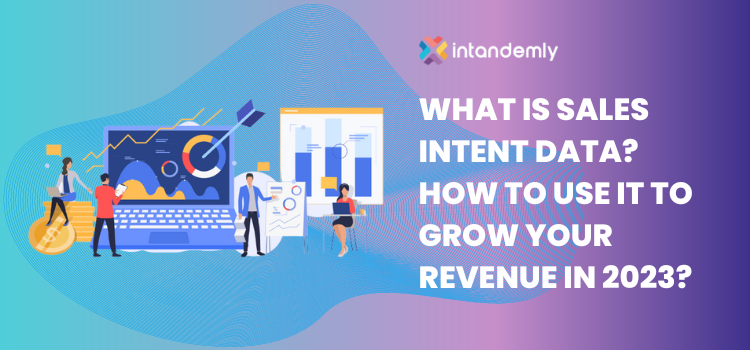What is Sales Intent Data? How to use it to grow your revenue in 2023?
Introduction
Sales intent data is an important component for any business out there in the market. It helps to understand the intent of customers and prospects, their buying behaviors, and the product or service they are looking for.What is Sales Intent Data?
Sales intent data is a type of data that can be used to identify what the customer needs and what they are looking for. This information can then be used to improve customer experience by making sure that they get what they want promptly.
Why Sales Intent Data is Crucial?
Sales intent data is a crucial element in predictive analytics. It helps sales teams to identify the leads that are most likely to convert into customers. This data is collected from various sources like call recordings, emails, and social media interactions.
The predictive analytics software can then be used to find out the probability of conversion for a given prospect. The sales team can then use this information to prioritize their outreach, while also being able to prove the ROI of their marketing campaigns.
What is the Role of Sales Intention Data in the Business World?
Sales intent data is the foundation of CRM. It helps marketers and salespeople understand the customer journey, their needs, and how they interact with other channels.Sales intention data is a collection of information that includes what products customers are interested in and how they intend to use them. It also includes when they are planning to purchase, what products they are using now, what their interests are, and so on.
The strategic importance of sales intention data cannot be understated because it provides insight into customer behavior and allows companies to personalize marketing campaigns accordingly.
How can Sales Intent Data increase revenue?
Sales intent data is a valuable tool that can be used to generate more revenue for your company. This data can be collected from customer surveys and analyzed to understand what they want and how they want it.The first step in using sales intent data is to create a baseline of the current situation. This will give you an idea of what you need to work on in order to increase revenue. You have to identify the problems and then find solutions that will help you reach your goal. The second step is creating a plan for how you will execute this strategy. You need to decide on the best time of day, week, or month for this strategy, as well as how much budget you are willing to allocate for it.
How Account-based Sales Help to Not Waste Money on Unwanted Prospects & Markets?
The account-based sales model is a data-driven approach to selling products and services. The model focuses on the most important customer segments and markets, which in turn helps the company to not waste money on unwanted prospects or markets.Account-based sales have been around for decades but it has only become popular in recent years. The main reason for this is that it can be difficult to measure the return on investment in traditional marketing models. Account-based sales help companies to measure the ROI of their marketing efforts by focusing on key accounts and eliminating wasteful spending.
How You Can Use Sales CRM Platforms to Assess Your Sales Readiness?
Sales CRM Platforms are a great way to assess your sales readiness. They can help you identify your strengths and weaknesses, and provide you with the resources to improve.You can use these platforms to understand your sales pipeline, identify opportunities, and get a complete view of who is in the market for your product or service.
Sales CRM platforms are an essential tool for any company that wants to be successful in today's competitive market.
How Can I Collect Sales Intent Data For My Business, Organization or Startup?
Understanding Intent Data Types
One approach to understanding intent data types is to think about them like hits on an objective. In the center (closer to the bullseye), you get hits that are clearly and firmly connected with your organization. Consider these as high scores. As you move outwards, the hits are further from the imprint, meaning the association with what you sell is less unambiguous.
Here are the four fundamental kinds of intent-based focusing on data, and how they collect:
- Search Intent
Search terms could have various implications for instance, "Free CRM Software" can be tracked down through the analytics. That is the reason we have splendid Web optimization individuals to change labels and content as per a wide range of puzzling standards.
- Engagement
- Profiling
- Technical
How Is Intent Data Gathered?
With each innovation, there are more ways for marketers and salespeople to assemble data on prospects. In any case, each source will squeeze into one of these classes:First-party
The data that your association gets straightforwardly from its digital properties make up first-party sources. Event triggers that happen on a website, CRM, and blogs the entire fall into this classification. Note that not all engagement data is first-party data. For instance, retweets are not produced straight by an organization's properties.
Second-party
This is another type of intent data marketing where Organization A gathers data about Organization B based on data furnished by open engagement with Organization A.
That is an extravagant approach to depicting companies like SoftwareAdvice.com, G2.com, Capterra.com and GetApp.com.
For instance, Capterra.com 'Organization A' surveys different innovation companies, and when clients search for more data on a specific one like 'Organization B', Capterra fetches that data.
Third-party
From the telephone registry to assortment firms, third-party intent data providers accumulate general data about associations and businesses. This is generally a mass of data, so third-party intent-based marketing data is an effective method for making an enormous rundown of top-of-funnel prospects that can then be reduced through outbound sales strategies.
